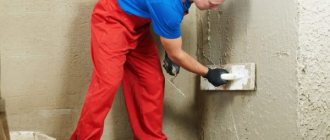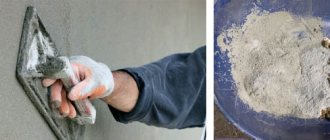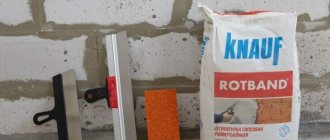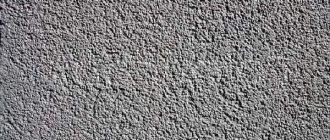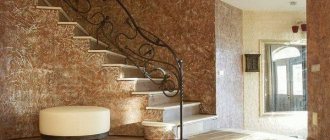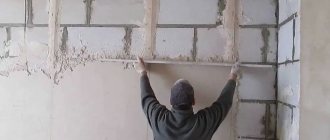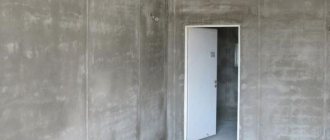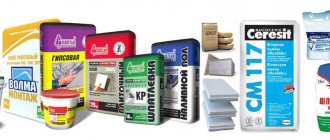Specify the parameters of the wall for plaster, the brand of your dry mixture and the consumption will be calculated automatically. (Attention! Separate a fraction from a number with a “period”, not a “comma”!)
| Wall length | m | Bags required: - or - Click the button to calculate |
| Wall height | m | |
| Average layer thickness | mm | |
| Type of plaster | ||
| Weight of a bag of plaster | kg |
What determines the consumption of plaster?
The first is the unevenness of the surface.
An indicator such as the curvature of the walls significantly affects the amount of mixture consumed. In new houses, the deviation of each wall horizontally and vertically can reach 2-2.5 cm, and in old rooms there are significant depressions and cracks, each of which must be carefully processed, and the entire surface perfectly leveled. The second factor is the type of plaster used. The material from which a certain type of plaster is made has its own technological consumption rate. For example, the consumption of gypsum plaster will be 8.5-10 kg per 1 square meter with a layer of 1 cm, and the consumption of cement plaster mixture will be 12-20 kg per 1 m2 with a thickness of 1 cm.
Characteristics
The choice of cement plaster composition for walls is determined by the following features:
- characteristics of the base;
- method of application;
- quality of the applied mixture.
According to the purpose of application, the compositions are divided into categories:
- simple, eliminating irregularities and defects in the base;
- special, containing additives to impart the necessary properties;
- decorative, or finishing, used for finishing.
Cement plaster is widely used and can withstand climatic conditions outside and inside the house.
Surface structure before finishing
Plaster consumption per 1 m2: main types
Any plaster mixtures are classified according to purpose (for external or internal work, for rooms with high humidity, repair, priming, restoration, thermal insulation and others);
by the type of binder component (cement, gypsum, lime, mixed type and with the addition of polymers) and by the dispersion of the filler (coarse-grained, fine-grained). Various manufacturers indicate the consumption rate of a certain type of produced plaster on the packaging; the volume of material consumed is indicated in kg per square meter with a layer thickness of 1 cm.
Features of preparing the solution yourself
The finishing composition is produced in two stages:
- preparation of dry mixture;
- water dilution.
All ingredients are mixed in a wooden, metal, or plastic container of a suitable size with a flat bottom.
Attention: when preparing the pasta, you must ensure that no dry mixture remains in the corners of the box. This may cause lumps to form.
Container for preparing the solution, photo
There are two ways to make plaster. With the manual method, sand is poured into the bottom of the tank, evenly distributing the binder over its surface. The ingredients are mixed with a shovel until smooth, then diluted with water to the required consistency.
Preparing the finishing mixture manually
To mix the ingredients of the paste using a mechanized method, a mixer or concrete mixer is used. All components must be poured into a special container, and then, adding water, mix until smooth.
The solution is mixed mechanically with a special mixer attachment.
The consistency of the plaster depends on the ratio of water and dry mixture. The liquid should be added gradually, thoroughly mixing with the bulk ingredients. The optimal solution for plastering walls is one in which the proportions between the components are correct. If there is a lot of binding material, the result is a fatty mass, which is consumed in large quantities and, when dried, gives sediment and cracks. If the amount of aggregate exceeds the binder, the result will be a lean mass with low strength.
Advice: novice builders are better off using ready-made dry mixtures, which just need to be diluted with water. Their consumption rates and dilution instructions are indicated on the packaging.
The optimal finishing mixture should have the consistency of sour cream
The video will demonstrate how to prepare plaster using a drill:
Consumption of gypsum plaster per m2 of wall
The consumption of gypsum plaster is on average 9 kg. This mixture is very convenient to use as it is easy to apply and dries quickly. The advantages include the fact that gypsum creates a perfectly smooth surface, eliminating any roughness. This allows you to begin the final coating immediately without resorting to additional finishing. Disadvantages include low impact resistance and poor moisture resistance.
It is not recommended to use
gypsum plaster in bathrooms, swimming pools and other rooms with high humidity.
Consumption of cement plaster per m2 of wall
Cement plaster is the most popular of all. The main binding material is cement. Usually, in order to prepare a plaster mixture, sand and water are added to cement in the required proportions. This composition is distinguished by its durability and strength. And thanks to its good moisture resistance, it can be used in damp, wet and unheated rooms. Sometimes in construction and repair work, cement is used for facade and interior decoration with the addition of other components such as lime, various polymers and mineral fillers, and PVA glue.
Additives to cement are used to improve the properties of the plaster mixture, increase elasticity, vapor permeability, and thermal insulation. Compared to other types of plaster, cement is the most accessible and inexpensive. Its consumption is on average 17 kg per 1 m2.
Video description
In the video, the master talks about the simplest way to calculate the required number of bags of plaster mixture:
More recently, when there were no ready-made mixtures on sale, plaster was made by hand using sand, cement and water. For interior work, lime was used instead of cement. And since the most expensive material is cement, builders have always had a question: what should be the consumption of cement per 1 m² of plaster.
Today no one asks this question. No one mixes a bunch of ingredients, preparing mixtures and solutions. Moreover, no one has ever been able to accurately follow the recipe. And the quality suffered as a result.
It is better to make the bottom leveling layer from cheap cement plaster Source yandex.net
Consumption of cement-lime plaster per m2 of wall
Cement-lime plaster is made by adding cement, lime and sand in the required proportions.
The average consumption of cement-lime plaster mixture is 16 kg, depending on the thickness of the layer. It is worth considering that this type of plaster is rarely applied in a layer of 1-1.5 cm, the minimum thickness is 3 cm. Many types of plaster mixtures, due to their composition and texture, have their own decorative value and can be used as a finishing touch. Based on their composition, they distinguish between lime-sand, acrylic, silicone and silicate decorative plasters, and their consumption depends on the technological properties of the material used. Decorative plaster mixtures are distinguished by their efficiency; usually finishing takes about 8 kg per square meter. For example, Rotband plaster is a dry mixture of gypsum and polymers. Sold packaged in paper bags. Method of preparation: according to the instructions, the dry powder is diluted with water to a paste. The main purpose is manual high-quality finishing of ceilings and walls. Can only be used in rooms with normal humidity levels. The consumption of Rotband plaster is 8.5 kg per 1m2.
Plaster composition
Plasters have different compositions: clay, lime, gypsum, cement, but the most common are cement plasters, which have great durability and stability. To impart the necessary qualities, various additives are introduced.
Types of cement mortar:
- Cement, which consists of cement and sand fraction, is used for plastering internal and external elements.
- Lime, to which lime milk is added, which increases the plasticity of the mixture, is also used inside and outside.
- Cement-clay is recommended for use in conditions of low humidity.
The use of a particular composition is determined by operating conditions.
At high humidity inside and for finishing facades, cement and lime mortars of the required strength are used.
Finished walls
At low humidity, lime plaster and lime-gypsum mixtures can be used for interior and exterior decoration.
What is the consumption of decorative bark beetle plaster?
Decorative bark beetle plaster is used to give relief to the surfaces of walls and ceilings. This type of plaster is characterized by weather resistance and good performance. Scope of application: both interior and exterior decoration. Sold dry - in bags and buckets - ready for use. Manufacturers indicate the consumption of bark beetle plaster from 2.5 - 3 kg per 1 m2 with a layer of 1 mm, depending on the size of the crumbs included in its composition. The higher the grain size of the mixture, the greater the consumption of the mixture.
There is such a variety of plaster mixtures on the market for construction and finishing materials that this will allow us to find a solution for each buyer, taking into account all the requirements, features of the repair and the conditions of the work being carried out.
How to make a calculation?
In its basic form, calculating the need for plaster is quite simple: we take the area of the surface to be repaired, multiply it by the thickness of the intended layer and get the required result. But there are certain features that have to be taken into account even if the calculation actions are performed using special software.
The most common mistakes made when determining the consumption of cement plaster per 1 m2 of wall are:
- inattention in calculations, entering incorrect formats into an online calculator;
- ignoring surface curvature and angles.
To accurately determine the consumption of dry mixture per 1 m2 of plaster, you must first thoroughly clean the surface, removing from it the remnants of the old finishing layer and crumbling pieces of plaster mortar, if any. After this, several actions are performed in the following sequence:
- using a plumb line, the level of the wall is specified, three points are determined with indicators of their deviations;
- all obtained measurement values are added up;
- the amount is divided by the number of points we have determined (in this case, three, but if there are more, the results will be more accurate), and the average thickness of the plaster to be applied is found.
Before establishing the exact consumption of the cement-sand mixture for finishing one square section of the wall, you should take into account that the beacons for plastering have a minimum thickness of six millimeters. Consequently, when the deviations are small and in some places do not exceed the height of the beacon, you will have to use a level with a laser beam in the process, or prepare reference marks from the mortar mixture with your own hands.
